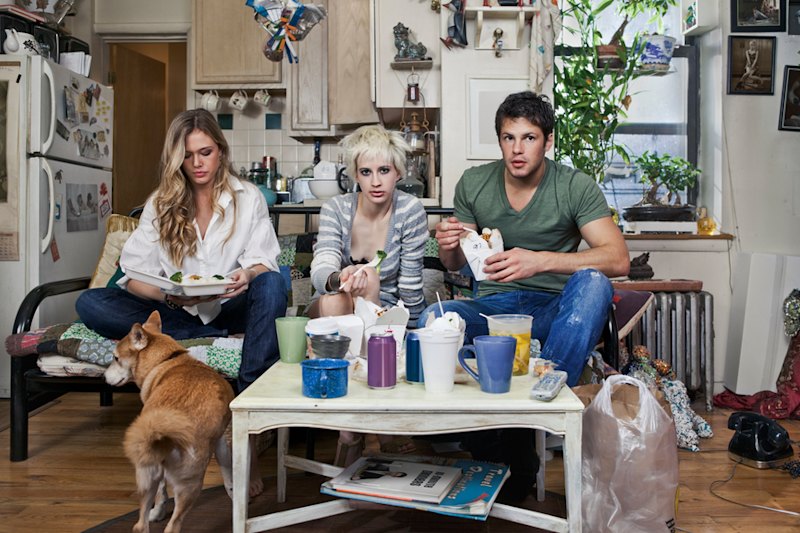Decluttering tips that actually work, according to a professional organiser

Just like a clear inbox can make you feel more efficient, a well-organised home can boost your productivity levels.
To help you start on the right foot, we tapped professional organiser Shira Gill to give us decluttering tips to organise every room in the house. Best of all, you can tackle it all in one weekend – no need to wait for spring-cleaning.
In the bathroom
Divide and conquer: “Take everything out of the medicine cabinet, and clear out drawers and shelves so you can edit before you organise,” Gill says. “Make sure to take the time to toss expired makeup, first-aid products, and medications. Once you have edited, you can relocate extra towels, occasional-use products, first aid, and medications into labelled bins in your linen closet. Drawer dividers or shallow bins will keep your toiletries and makeup organised in the bathroom.”
Store fewer, better products: “Treat yourself to high-quality makeup, perfume, hand soap, and bath products, since they are items you use every single day,” she adds. “Invest in beautiful products you love, and use them up completely before purchasing new products so your bathroom doesn’t turn into a graveyard for unused products.”
Hang it up: “Hooks are handy for hanging bath and hand towels, robes, and even watches or jewellery for when you are showering or washing your face,” she says. “Make sure to mount hooks at arm’s reach for easy access.”
In the kitchen
Cut counter clutter: “Kitchen surfaces tend to be a magnet for clutter,” says the professional organiser. “The buildup happens when household items, mail, and paperwork don’t have a clearly assigned home. Take a few minutes to relocate what doesn’t belong in the kitchen and make sure to assign a permanent home for items like mail or current work projects that get dumped on your counter and turn into stacks of clutter.”
- Related: Can a blanket really improve your health?
- Related: How to prepare your home for a fast sale
- Related: Products to help you banish plastic
Edit your pantry: “Give your pantry a clean slate by taking everything out, wiping down shelves, and eliminating any expired items,” she says. “Any unwanted products can be composted or donated to your local food bank. Once you’ve edited, take the time to group similar items together by type—pasta and grains, snacks and sweets. Once you have grouped everything by type, you can store items according to usage—items you use every day like breakfast cereal should be stored at arm’s reach, while holiday baking items can be tucked away on a high shelf.”
Streamline your storage: “For a stylish and sustainable pantry makeover, airtight labelled jars create a clean, streamlined look, and they keep your snack and pantry items fresher for longer,” she adds. “Using clear jars maximises space and also makes it easy to see when items need to be replenished. Once you are all set up, it’s easy to restock your pantry by shopping in the bulk bins at your local market. This tiny shift will save you money, reduce your environmental footprint, and make your shelves look lovely. A total win!”
In the bedroom
Nightstand Makeover: “Is your nightstand covered in stacks of books, mail, and bills? This little surface deserves a makeover,” Gill says. “Clear your nightstand completely and wipe down for a fresh start. Relocate any unnecessary or misplaced items, and stock your nightstand drawer with only the essentials: reading glasses, current books or magazines, lip balm, hand cream, or anything else you like regular access to before sleep. Select a few pretty objects to style the surface of your nightstand. I find that intentionally styled surfaces discourage the dreaded clutter piles from forming. Favourite styling objects include fresh flowers or a potted plant, scented candles, pretty rocks or sculptural objects, a ceramic dish for jewellery, and framed photos.”
Make Your Bed: “In most bedrooms, the bed takes up the single largest percentage of space. So just by pulling your covers up and fluffing a few pillows, your room will look instantly more pulled together and polished,” she adds. “Think about how good it feels to check into a nice hotel. Why not create a relaxing sanctuary in your own home? You get to decide how your space looks and feels—make it feel as lovely and restorative as possible! When I come home from a long day, there is nothing better than collapsing into a beautifully made bed with a good book or magazine. Think of making the bed as a gift you can give yourself.”
In the closet
Your closet should reflect your life: “Most people have overstuffed closets filled with items they rarely or never wear,” Gill says. “Imagine if your closet was like a well-curated boutique filled with items that you loved. Take some time to select the clothes that make sense for your weekly routine (work, fitness, events) and also fit and flatter your current body. Donate or consign the rest and make sure to keep a basket or tote bag accessible for storing donations as they arise. When the bag is full, drop off the donations so you can maintain a streamlined closet.”
Zone by usage: “Try to keep everyday wardrobe staples visible for easy access and formal, seasonal, and occasional items in the back of the closet or on a high shelf,” she adds. “Formal shoes can be stored on high shelves stacked in clear shoeboxes. Flip-flops, sandals, and sneakers work well in a round basket on the floor for easy access.”
Banish wire hangers: “Create a stylish, streamlined look in by using uniform hangers and arranging hanging items by type, style, and colour,” she says. “Pick one style and colour of bin or basket for accessories to keep everything looking clean and easy on the eyes.”
In the laundry
Go vertical: “Maximise vertical space by installing adjustable wall shelves,” Gill says. “Stock the shelves with detergents, dryer sheets, and stain removers. A tension rod can be handy for hanging clothing to dry and you can wall-mount your iron and ironing board to maximise shelf space.”
Decant detergent: “Decant powdered detergent into clear jars with scoops so you can see when you’re running low,” she adds. “Stain removers and liquid soap can be poured into olive oil jars with spouts for spill-proof pouring.”
Pre-sort your clothes: “Save time by pre-sorting whites and darks in a divided laundry bin,” she says. “Keep a labelled canvas tote in your closet for dry cleaning and repairs and a small bin is handy for tossing unmatched socks. If you don’t find a mate within a month, it’s safe to say ‘adieu’ to those solo socks.”
– A version of this story originally appeared on My Domaine Home.
We recommend
We thought you might like
States
Capital Cities
Capital Cities - Rentals
Popular Areas
Allhomes
More







